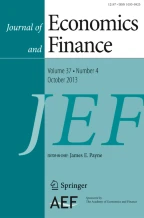Abstract
The purpose of this paper is to examine whether executive stock-based compensation incentives induce the relation between accrual-based earnings management (AEM) and real earnings management (REM) to become asymmetric. The empirical results show that there is the substitute relation between AEM and REM when CEOs have the lowest degree of stock-based compensation incentives. However, there is the complementary relation between AEM and REM when CEOs have the median degree of stock-based compensation incentives. Moreover, the results also present a trade-off relation exists in the highest degree financial incentives during the post-SOX period, but this relation does not exist in the same regime during the pre-SOX period. These findings provide new insight into executive compensation mechanism for shareholders, investors, and regulators, resulting in the efficiency to prevent managers from obtaining private gains at shareholders’ expense.
Similar content being viewed by others
Notes
The F statistic can be expressed as follows: \( F=\frac{S_0-{S}_1\left(\widehat{\gamma}\right)}{{\widehat{\sigma}}^2} \), where S0 and \( {S}_1\left(\widehat{\gamma}\right) \) are sums of squared errors under null and alternative hypotheses, respectively. However, the asymptotic distribution of F is non-standard, and hence following the bootstrap method proposed by Hansen (1999), we obtain the approximations of the F statistics and then calculate the p-values by repeating 1000 times bootstrap procedure. If the p-value is less than significance levels, the null hypothesis is rejected and implying there is a threshold effect in the regression.
Following the assumption of Bergstresser and Philippon (2006), the “delta” of the options in the CEO’s portfolio is one. That is to say, a dollar increase in the price of a firm’s share translates one-for-one to the value of an option.
References
Bergstresser D, Philippon T (2006) CEO incentives and earnings management. J Financ Econ 80:511–529
Carter ME, Lynch LJ, Tuna I (2007) The role of accounting in the design of CEO stock compensation. Account Rev 82:327–357
Chen C-L, Chou P-I, Chen Y-C, Lin AY (2015) The effect of real activity earnings management on price valuation implication. Adv Quant Anal Finan Acc 13:91–122
Cheng Q, Warfield TD (2005) Equity incentives and earnings management. Account Rev 80:441–476
Cohen DA, Zarowin P (2010) Accrual-based and real earnings management activities around seasoned equity offerings. J Account Econ 50:2–19
Cohen DA, Dey A, Lys TZ (2008) Real and accrual-based earnings management in the pre- and post-Sarbanes-Oxley periods. Account Rev 83:757–787
Cohen DA, Dey A, Lys TZ (2009) The Sarbanes Oxley act of 2002: implications for compensation contracts and managerial risk-taking. SSRN Working paper
Collins D, Hribar P (2000) Earnings-based and accrual-based market anomalies: one effect or two? J Account Econ 29:101–123
Dechow PM, Skinner DJ (2000) Earnings management: reconciling the views of accounting academics, practitioners, and regulators. Account Horiz 14:235–250
Dechow PM, Sloan R, Sweeney AP (1995) Detecting earnings management. Account Rev 70:193–225
DuCharme LL, Malatesta PH, Sefcik SE (2004) Earnings management, stock issues, and shareholder lawsuits. J Financ Econ 71:27–49
Ewert R, Wagenhofer A (2005) Economic effect of tightening accounting standards to restrict earnings management. Account Rev 80:1101–1124
Fabrizi M, Parbonetti A (2016) CEO risk incentive and real earnings management. Int J Bus Manag 11:37–51
Graham JR, Harvey CR, Rajgopal S (2005) The economic implications of corporate financial reporting. J Account Econ 40:3–73
Guay W (1999) The sensitivity of CEO wealth to equity risk: an analysis of the magnitude and determinants. J Financ Econ 53:43–71
Hanlon M, Rajgopal S, Shevlin T (2003) Are executive stock options associated with future earnings. J Account Econ 36:3–43
Hansen BE (1999) Threshold effects in non-dynamic panels: estimation, testing and inference. J Econ 93:345–368
Ittner CD, Lambert RA, Larcker DF (2003) The structure and performance consequences of equity grants to employees of new economy firms. J Account Econ 34:89–127
Jensen M, Meckling W (1976) Theory of the firm: managerial behavior, agency costs and ownership structure. J Financ Econ 3:305–360
Jones J (1991) Earnings management during import relief investigations. J Account Res 29:193–228
Kadan O, Yang J (2016) Executive stock options and earnings management: a theoretical and empirical analysis. Quart J of Fin 06:1650003
Lovata LM, Schoenecker TS, Costigan ML (2016) CEO characteristics, compensation and real activity management in manufacturing companies. Acad Account Finance Stud J 20:103–114
Mehran H (1995) Executive compensation structure, ownership, and firm performance. J Financ Econ 38:163–184
Michelson SE, Jordan-Wagner J, Wootton CW (2000) The relationship between the smoothing of reported income and risk-adjusted returns. J Econ Financ 24:141–159
Nagar V, Nanda D, Wysocki P (2003) Discretionary disclosure and compensation policy. J Account Econ 7:11–42
Rangan S (1998) Earnings before seasoned equity offerings: are they overstated? J Financ Econ 50:101–122
Roychowdhury S (2006) Earning management through real activities manipulation. J Account Econ 42:335–370
Schipper K (1989) Commentary on earnings management. Account Horiz 3:91–102
Shivakumar L (2000) Do firms mislead investor by overstating earnings before seasoned equity offerings? J Account Econ 29:339–371
Teoh SH, Welch I, Wong TJ (1998) Earnings management and the long-run performance of seasoned equity offerings. J Financ Econ 50:63–100
Zang AZ (2012) Evidence on the tradeoff between real manipulation and accrual manipulation. Account Rev 87:675–703
Acknowledgements
We gratefully acknowledge National Science Council for providing financial support for this project (NSC 102-2410-H-180-001-).
Author information
Authors and Affiliations
Corresponding author
Rights and permissions
About this article
Cite this article
Chou, PI., Lee, CH. The asymmetric relation between earnings management behaviors: evidence from executive compensation incentives. J Econ Finan 42, 765–778 (2018). https://doi.org/10.1007/s12197-018-9426-1
Published:
Issue Date:
DOI: https://doi.org/10.1007/s12197-018-9426-1
